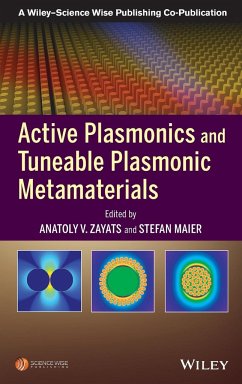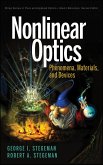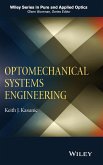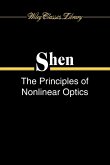- Gebundenes Buch
- Merkliste
- Auf die Merkliste
- Bewerten Bewerten
- Teilen
- Produkt teilen
- Produkterinnerung
- Produkterinnerung
This book, edited by two of the most respected researchers in plasmonics, gives an overview of the current state in plasmonics and plasmonic-based metamaterials, with an emphasis on active functionalities and an eye to future developments. This book is multifunctional, useful for newcomers and scientists interested in applications of plasmonics and metamaterials as well as for established researchers in this multidisciplinary area.
Andere Kunden interessierten sich auch für
![Nonlinear Optics Nonlinear Optics]() George I. StegemanNonlinear Optics127,99 €
George I. StegemanNonlinear Optics127,99 €![Photonic Quantum Technologies. Two-volume set Photonic Quantum Technologies. Two-volume set]() Photonic Quantum Technologies. Two-volume set188,99 €
Photonic Quantum Technologies. Two-volume set188,99 €![Optomechanical Systems Engineering Optomechanical Systems Engineering]() Keith J. KasunicOptomechanical Systems Engineering137,99 €
Keith J. KasunicOptomechanical Systems Engineering137,99 €![The Principles of Nonlinear Optics The Principles of Nonlinear Optics]() Yuen R. ShenThe Principles of Nonlinear Optics154,99 €
Yuen R. ShenThe Principles of Nonlinear Optics154,99 €![Laser Applications in Surface Science and Technology Laser Applications in Surface Science and Technology]() Horst-Günter RubahnLaser Applications in Surface Science and Technology228,99 €
Horst-Günter RubahnLaser Applications in Surface Science and Technology228,99 €![Optics Liquid Crystal Displays Optics Liquid Crystal Displays]() Pochi YehOptics Liquid Crystal Displays213,99 €
Pochi YehOptics Liquid Crystal Displays213,99 €![Color Science Color Science]() Günther WyszeckiColor Science155,99 €
Günther WyszeckiColor Science155,99 €-
-
-
This book, edited by two of the most respected researchers in plasmonics, gives an overview of the current state in plasmonics and plasmonic-based metamaterials, with an emphasis on active functionalities and an eye to future developments. This book is multifunctional, useful for newcomers and scientists interested in applications of plasmonics and metamaterials as well as for established researchers in this multidisciplinary area.
Hinweis: Dieser Artikel kann nur an eine deutsche Lieferadresse ausgeliefert werden.
Hinweis: Dieser Artikel kann nur an eine deutsche Lieferadresse ausgeliefert werden.
Produktdetails
- Produktdetails
- A Wiley-Science Wise Co-Publication .1
- Verlag: Wiley & Sons
- 1. Auflage
- Seitenzahl: 336
- Erscheinungstermin: 15. Juli 2013
- Englisch
- Abmessung: 240mm x 161mm x 23mm
- Gewicht: 661g
- ISBN-13: 9781118092088
- ISBN-10: 1118092082
- Artikelnr.: 36899899
- Herstellerkennzeichnung
- Libri GmbH
- Europaallee 1
- 36244 Bad Hersfeld
- gpsr@libri.de
- A Wiley-Science Wise Co-Publication .1
- Verlag: Wiley & Sons
- 1. Auflage
- Seitenzahl: 336
- Erscheinungstermin: 15. Juli 2013
- Englisch
- Abmessung: 240mm x 161mm x 23mm
- Gewicht: 661g
- ISBN-13: 9781118092088
- ISBN-10: 1118092082
- Artikelnr.: 36899899
- Herstellerkennzeichnung
- Libri GmbH
- Europaallee 1
- 36244 Bad Hersfeld
- gpsr@libri.de
ANATOLY V. ZAYATS, PhD, is Professor of Experimental Physics and the Head of the Experimental Biophysics and Nanotechnology Group at King's College London. He also leads the UK EPSRC research program on active plasmonics. He is a Fellow of the Institute of Physics, the Optical Society of America, and SPIE. STEFAN MAIER, PhD, is the Co-Director of the Centre for Plasmonics and Metamaterials at Imperial College London. He was the recipient of the 2010 Sackler Prize in the Physical Sciences and the 2010 Paterson Medal of the Institute of Physics. A Fellow of the OSA and Institute of Physics, Dr. Maier has published over 130 journal articles in the area of nanoplasmonics, and is a frequent invited speaker at international conferences.
Preface xiii
Contributors xvii
1 Spaser, Plasmonic Amplification, and Loss Compensation 1
Mark I. Stockman
1.1 Introduction to Spasers and Spasing 1
1.2 Spaser Fundamentals 2
1.2.1 Brief Overview of the Latest Progress in Spasers 5
1.3 Quantum Theory of Spaser 7
1.3.1 Surface Plasmon Eigenmodes and Their Quantization 7
1.3.2 Quantum Density Matrix Equations (Optical Bloch Equations) for Spaser
9
1.3.3 Equations for CW Regime 11
1.3.4 Spaser operation in CW Mode 15
1.3.5 Spaser as Ultrafast Quantum Nanoamplifier 17
1.3.6 Monostable Spaser as a Nanoamplifier in Transient Regime 18
1.4 Compensation of Loss by Gain and Spasing 22
1.4.1 Introduction to Loss Compensation by Gain 22
1.4.2 Permittivity of Nanoplasmonic Metamaterial 22
1.4.3 Plasmonic Eigenmodes and Effective Resonant Permittivity of
Metamaterials 24
1.4.4 Conditions of Loss Compensation by Gain and Spasing 25
1.4.5 Discussion of Spasing and Loss Compensation by Gain 27
1.4.6 Discussion of Published Research on Spasing and Loss Compensations 29
2 Nonlinear Effects in Plasmonic Systems 41
Pavel Ginzburg and Meir Orenstein
2.1 Introduction 41
2.2 Metallic Nonlinearities-Basic Effects and Models 43
2.2.1 Local Nonlinearity-Transients by Carrier Heating 43
2.2.2 Plasma Nonlinearity-The Ponderomotive Force 45
2.2.3 Parametric Process in Metals 46
2.2.4 Metal Damage and Ablation 48
2.3 Nonlinear Propagation of Surface Plasmon Polaritons 49
2.3.1 Nonlinear SPP Modes 50
2.3.2 Plasmon Solitons 50
2.3.3 Nonlinear Plasmonic Waveguide Couplers 54
2.4 Localized Surface Plasmon Nonlinearity 55
2.4.1 Cavities and Nonlinear Interactions Enhancement 56
2.4.2 Enhancement of Nonlinear Vacuum Effects 58
2.4.3 High Harmonic Generation 60
2.4.4 Localized Field Enhancement Limitations 60
2.5 Summary 62
3 Plasmonic Nanorod Metamaterials as a Platform for Active Nanophotonics 69
Gregory A. Wurtz, Wayne Dickson, Anatoly V. Zayats, Antony Murphy, and
Robert J. Pollard
3.1 Introduction 69
3.2 Nanorod Metamaterial Geometry 71
3.3 Optical Properties 72
3.3.1 Microscopic Description of the Metamaterial Electromagnetic Modes 72
3.3.2 Effective Medium Theory of the Nanorod Metamaterial 76
3.3.3 Epsilon-Near-Zero Metamaterials and Spatial Dispersion Effects 79
3.3.4 Guided Modes in the Anisotropic Metamaterial Slab 82
3.4 Nonlinear Effects in Nanorod Metamaterials 82
3.4.1 Nanorod Metamaterial Hybridized with Nonlinear Dielectric 84
3.4.2 Intrinsic Metal Nonlinearity of Nanorod Metamaterials 85
3.5 Molecular Plasmonics in Metamaterials 89
3.6 Electro-Optical Effects in Plasmonic Nanorod Metamaterial Hybridized
with Liquid Crystals 97
3.7 Conclusion 98
4 Transformation Optics for Plasmonics 105
Alexandre Aubry and John B. Pendry
4.1 Introduction 105
4.2 The Conformal Transformation Approach 108
4.2.1 A Set of Canonic Plasmonic Structures 109
4.2.2 Perfect Singular Structures 110
4.2.3 Singular Plasmonic Structures 114
4.2.3.1 Conformal Mapping of Singular Structures 114
4.2.3.2 Conformal Mapping of Blunt-Ended Singular Structures 118
4.2.4 Resonant Plasmonic Structures 119
4.3 Broadband Light Harvesting and Nanofocusing 121
4.3.1 Broadband Light Absorption 121
4.3.2 Balance between Energy Accumulation and Dissipation 123
4.3.3 Extension to 3D 125
4.3.4 Conclusion 126
4.4 Surface Plasmons and Singularities 127
4.4.1 Control of the Bandwidth with the Vertex Angle 127
4.4.2 Effect of the Bluntness 129
4.5 Plasmonic Hybridization Revisited with Transformation Optics 130
4.5.1 A Resonant Behavior 131
4.5.2 Nanofocusing Properties 132
4.6 Beyond the Quasi-Static Approximation 133
4.6.1 Conformal Transformation Picture 134
4.6.2 Radiative Losses 135
4.6.3 Fluorescence Enhancement 137
4.6.3.1 Fluorescence Enhancement in the Near-Field of Nanoantenna 138
4.6.3.2 The CT Approach 139
4.7 Nonlocal effects 142
4.7.1 Conformal Mapping of Nonlocality 142
4.7.2 Toward the Physics of Local Dimers 143
4.8 Summary and Outlook 145
5 Loss Compensation and Amplification of Surface Plasmon Polaritons 153
Pierre Berini
5.1 Introduction 153
5.2 Surface Plasmon Waveguides 154
5.2.1 Unidimensional Structures 154
5.2.2 Bidimensional Structures 156
5.2.3 Confinement-Attenuation Trade-Off 156
5.2.4 Optical Processes Involving SPPs 157
5.3 Single Interface 157
5.3.1 Theoretical 157
5.3.2 Experimental 158
5.4 Symmetric Metal Films 160
5.4.1 Gratings 160
5.4.2 Theoretical 160
5.4.3 Experimental 161
5.5 Metal Clads 163
5.5.1 Theoretical 164
5.5.2 Experimental 164
5.6 Other Structures 164
5.6.1 Dielectric-Loaded SPP Waveguides 164
5.6.2 Hybrid SPP Waveguide 165
5.6.3 Nanostructures 166
5.7 Conclusions 166
6 Controlling Light Propagation with Interfacial Phase Discontinuities 171
Nanfang Yu, Mikhail A. Kats, Patrice Genevet, Francesco Aieta, Romain
Blanchard, Guillaume Aoust, Zeno Gaburro, and Federico Capasso
6.1 Phase Response of Optical Antennas 172
6.1.1 Introduction 172
6.1.2 Single Oscillator Model for Linear Optical Antennas 174
6.1.3 Two-Oscillator Model for 2D Structures Supporting Two Orthogonal
Plasmonic Modes 176
6.1.4 Analytical Models for V-Shaped Optical Antennas 179
6.1.5 Optical Properties of V-Shaped Antennas: Experiments and Simulations
183
6.2 Applications of Phased Optical Antenna Arrays 186
6.2.1 Generalized Laws of Reflection and Refraction: Meta-Interfaces with
Phase Discontinuities 186
6.2.2 Out-of-Plane Reflection and Refraction of Light by Meta-Interfaces
192
6.2.3 Giant and Tuneable Optical Birefringence 197
6.2.4 Vortex Beams Created by Meta-Interfaces 200
7 Integrated Plasmonic Detectors 219
Pieter Neutens and Paul Van Dorpe
7.1 Introduction 219
7.2 Electrical Detection of Surface Plasmons 221
7.2.1 Plasmon Detection with Tunnel Junctions 221
7.2.2 Plasmon-Enhanced Solar Cells 222
7.2.3 Plasmon-Enhanced Photodetectors 225
7.2.4 Waveguide-Integrated Surface Plasmon Polariton Detectors 232
7.3 Outlook 236
8 Terahertz Plasmonic Surfaces for Sensing 243
Stephen M. Hanham and Stefan A. Maier
8.1 The Terahertz Region for Sensing 244
8.2 THz Plasmonics 244
8.3 SPPs on Semiconductor Surfaces 245
8.3.1 Active Control of Semiconductor Plasmonics 247
8.4 SSPP on Structured Metal Surfaces 247
8.5 THz Plasmonic Antennas 249
8.6 Extraordinary Transmission 253
8.7 THz Plasmons on Graphene 255
9 Subwavelength Imaging by Extremely Anisotropic Media 261
Pavel A. Belov
9.1 Introduction to Canalization Regime of Subwavelength Imaging 261
9.2 Wire Medium Lens at the Microwave Frequencies 264
9.3 Magnifying and Demagnifying Lenses with Super-Resolution 269
9.4 Imaging at the Terahertz and Infrared Frequencies 272
9.5 Nanolenses Formed by Nanorod Arrays for the Visible Frequency Range 276
9.6 Superlenses and Hyperlenses Formed by Multilayered Metal-Dielectric
Nanostructures 279
10 Active and Tuneable Metallic Nanoslit Lenses 289
Satoshi Ishii, Xingjie Ni, Vladimir P. Drachev, Mark D. Thoreson, Vladimir
M. Shalaev, and Alexander V. Kildishev
10.1 Introduction 289
10.2 Polarization-Selective Gold Nanoslit Lenses 290
10.2.1 Design Concept of Gold Nanoslit Lenses 291
10.2.2 Experimental Demonstration of Gold Nanoslit Lenses 292
10.3 Metallic Nanoslit Lenses with Focal-Intensity Tuneability and Focal
Length Shifting 295
10.3.1 Liquid Crystal-Controlled Nanoslit Lenses 295
10.3.2 Nonlinear Materials for Controlling Nanoslit Lenses 300
10.4 Lamellar Structures with Hyperbolic Dispersion Enable Subwavelength
Focusing with Metallic Nanoslits 301
10.4.1 Active Lamellar Structures with Hyperbolic Dispersion 302
10.4.2 Subwavelength Focusing with Active Lamellar Structures 307
10.4.3 Experimental Demonstration of Subwavelength Diffraction 308
10.5 Summary 313
Acknowledgments 313
References 313
Contributors xvii
1 Spaser, Plasmonic Amplification, and Loss Compensation 1
Mark I. Stockman
1.1 Introduction to Spasers and Spasing 1
1.2 Spaser Fundamentals 2
1.2.1 Brief Overview of the Latest Progress in Spasers 5
1.3 Quantum Theory of Spaser 7
1.3.1 Surface Plasmon Eigenmodes and Their Quantization 7
1.3.2 Quantum Density Matrix Equations (Optical Bloch Equations) for Spaser
9
1.3.3 Equations for CW Regime 11
1.3.4 Spaser operation in CW Mode 15
1.3.5 Spaser as Ultrafast Quantum Nanoamplifier 17
1.3.6 Monostable Spaser as a Nanoamplifier in Transient Regime 18
1.4 Compensation of Loss by Gain and Spasing 22
1.4.1 Introduction to Loss Compensation by Gain 22
1.4.2 Permittivity of Nanoplasmonic Metamaterial 22
1.4.3 Plasmonic Eigenmodes and Effective Resonant Permittivity of
Metamaterials 24
1.4.4 Conditions of Loss Compensation by Gain and Spasing 25
1.4.5 Discussion of Spasing and Loss Compensation by Gain 27
1.4.6 Discussion of Published Research on Spasing and Loss Compensations 29
2 Nonlinear Effects in Plasmonic Systems 41
Pavel Ginzburg and Meir Orenstein
2.1 Introduction 41
2.2 Metallic Nonlinearities-Basic Effects and Models 43
2.2.1 Local Nonlinearity-Transients by Carrier Heating 43
2.2.2 Plasma Nonlinearity-The Ponderomotive Force 45
2.2.3 Parametric Process in Metals 46
2.2.4 Metal Damage and Ablation 48
2.3 Nonlinear Propagation of Surface Plasmon Polaritons 49
2.3.1 Nonlinear SPP Modes 50
2.3.2 Plasmon Solitons 50
2.3.3 Nonlinear Plasmonic Waveguide Couplers 54
2.4 Localized Surface Plasmon Nonlinearity 55
2.4.1 Cavities and Nonlinear Interactions Enhancement 56
2.4.2 Enhancement of Nonlinear Vacuum Effects 58
2.4.3 High Harmonic Generation 60
2.4.4 Localized Field Enhancement Limitations 60
2.5 Summary 62
3 Plasmonic Nanorod Metamaterials as a Platform for Active Nanophotonics 69
Gregory A. Wurtz, Wayne Dickson, Anatoly V. Zayats, Antony Murphy, and
Robert J. Pollard
3.1 Introduction 69
3.2 Nanorod Metamaterial Geometry 71
3.3 Optical Properties 72
3.3.1 Microscopic Description of the Metamaterial Electromagnetic Modes 72
3.3.2 Effective Medium Theory of the Nanorod Metamaterial 76
3.3.3 Epsilon-Near-Zero Metamaterials and Spatial Dispersion Effects 79
3.3.4 Guided Modes in the Anisotropic Metamaterial Slab 82
3.4 Nonlinear Effects in Nanorod Metamaterials 82
3.4.1 Nanorod Metamaterial Hybridized with Nonlinear Dielectric 84
3.4.2 Intrinsic Metal Nonlinearity of Nanorod Metamaterials 85
3.5 Molecular Plasmonics in Metamaterials 89
3.6 Electro-Optical Effects in Plasmonic Nanorod Metamaterial Hybridized
with Liquid Crystals 97
3.7 Conclusion 98
4 Transformation Optics for Plasmonics 105
Alexandre Aubry and John B. Pendry
4.1 Introduction 105
4.2 The Conformal Transformation Approach 108
4.2.1 A Set of Canonic Plasmonic Structures 109
4.2.2 Perfect Singular Structures 110
4.2.3 Singular Plasmonic Structures 114
4.2.3.1 Conformal Mapping of Singular Structures 114
4.2.3.2 Conformal Mapping of Blunt-Ended Singular Structures 118
4.2.4 Resonant Plasmonic Structures 119
4.3 Broadband Light Harvesting and Nanofocusing 121
4.3.1 Broadband Light Absorption 121
4.3.2 Balance between Energy Accumulation and Dissipation 123
4.3.3 Extension to 3D 125
4.3.4 Conclusion 126
4.4 Surface Plasmons and Singularities 127
4.4.1 Control of the Bandwidth with the Vertex Angle 127
4.4.2 Effect of the Bluntness 129
4.5 Plasmonic Hybridization Revisited with Transformation Optics 130
4.5.1 A Resonant Behavior 131
4.5.2 Nanofocusing Properties 132
4.6 Beyond the Quasi-Static Approximation 133
4.6.1 Conformal Transformation Picture 134
4.6.2 Radiative Losses 135
4.6.3 Fluorescence Enhancement 137
4.6.3.1 Fluorescence Enhancement in the Near-Field of Nanoantenna 138
4.6.3.2 The CT Approach 139
4.7 Nonlocal effects 142
4.7.1 Conformal Mapping of Nonlocality 142
4.7.2 Toward the Physics of Local Dimers 143
4.8 Summary and Outlook 145
5 Loss Compensation and Amplification of Surface Plasmon Polaritons 153
Pierre Berini
5.1 Introduction 153
5.2 Surface Plasmon Waveguides 154
5.2.1 Unidimensional Structures 154
5.2.2 Bidimensional Structures 156
5.2.3 Confinement-Attenuation Trade-Off 156
5.2.4 Optical Processes Involving SPPs 157
5.3 Single Interface 157
5.3.1 Theoretical 157
5.3.2 Experimental 158
5.4 Symmetric Metal Films 160
5.4.1 Gratings 160
5.4.2 Theoretical 160
5.4.3 Experimental 161
5.5 Metal Clads 163
5.5.1 Theoretical 164
5.5.2 Experimental 164
5.6 Other Structures 164
5.6.1 Dielectric-Loaded SPP Waveguides 164
5.6.2 Hybrid SPP Waveguide 165
5.6.3 Nanostructures 166
5.7 Conclusions 166
6 Controlling Light Propagation with Interfacial Phase Discontinuities 171
Nanfang Yu, Mikhail A. Kats, Patrice Genevet, Francesco Aieta, Romain
Blanchard, Guillaume Aoust, Zeno Gaburro, and Federico Capasso
6.1 Phase Response of Optical Antennas 172
6.1.1 Introduction 172
6.1.2 Single Oscillator Model for Linear Optical Antennas 174
6.1.3 Two-Oscillator Model for 2D Structures Supporting Two Orthogonal
Plasmonic Modes 176
6.1.4 Analytical Models for V-Shaped Optical Antennas 179
6.1.5 Optical Properties of V-Shaped Antennas: Experiments and Simulations
183
6.2 Applications of Phased Optical Antenna Arrays 186
6.2.1 Generalized Laws of Reflection and Refraction: Meta-Interfaces with
Phase Discontinuities 186
6.2.2 Out-of-Plane Reflection and Refraction of Light by Meta-Interfaces
192
6.2.3 Giant and Tuneable Optical Birefringence 197
6.2.4 Vortex Beams Created by Meta-Interfaces 200
7 Integrated Plasmonic Detectors 219
Pieter Neutens and Paul Van Dorpe
7.1 Introduction 219
7.2 Electrical Detection of Surface Plasmons 221
7.2.1 Plasmon Detection with Tunnel Junctions 221
7.2.2 Plasmon-Enhanced Solar Cells 222
7.2.3 Plasmon-Enhanced Photodetectors 225
7.2.4 Waveguide-Integrated Surface Plasmon Polariton Detectors 232
7.3 Outlook 236
8 Terahertz Plasmonic Surfaces for Sensing 243
Stephen M. Hanham and Stefan A. Maier
8.1 The Terahertz Region for Sensing 244
8.2 THz Plasmonics 244
8.3 SPPs on Semiconductor Surfaces 245
8.3.1 Active Control of Semiconductor Plasmonics 247
8.4 SSPP on Structured Metal Surfaces 247
8.5 THz Plasmonic Antennas 249
8.6 Extraordinary Transmission 253
8.7 THz Plasmons on Graphene 255
9 Subwavelength Imaging by Extremely Anisotropic Media 261
Pavel A. Belov
9.1 Introduction to Canalization Regime of Subwavelength Imaging 261
9.2 Wire Medium Lens at the Microwave Frequencies 264
9.3 Magnifying and Demagnifying Lenses with Super-Resolution 269
9.4 Imaging at the Terahertz and Infrared Frequencies 272
9.5 Nanolenses Formed by Nanorod Arrays for the Visible Frequency Range 276
9.6 Superlenses and Hyperlenses Formed by Multilayered Metal-Dielectric
Nanostructures 279
10 Active and Tuneable Metallic Nanoslit Lenses 289
Satoshi Ishii, Xingjie Ni, Vladimir P. Drachev, Mark D. Thoreson, Vladimir
M. Shalaev, and Alexander V. Kildishev
10.1 Introduction 289
10.2 Polarization-Selective Gold Nanoslit Lenses 290
10.2.1 Design Concept of Gold Nanoslit Lenses 291
10.2.2 Experimental Demonstration of Gold Nanoslit Lenses 292
10.3 Metallic Nanoslit Lenses with Focal-Intensity Tuneability and Focal
Length Shifting 295
10.3.1 Liquid Crystal-Controlled Nanoslit Lenses 295
10.3.2 Nonlinear Materials for Controlling Nanoslit Lenses 300
10.4 Lamellar Structures with Hyperbolic Dispersion Enable Subwavelength
Focusing with Metallic Nanoslits 301
10.4.1 Active Lamellar Structures with Hyperbolic Dispersion 302
10.4.2 Subwavelength Focusing with Active Lamellar Structures 307
10.4.3 Experimental Demonstration of Subwavelength Diffraction 308
10.5 Summary 313
Acknowledgments 313
References 313
Preface xiii
Contributors xvii
1 Spaser, Plasmonic Amplification, and Loss Compensation 1
Mark I. Stockman
1.1 Introduction to Spasers and Spasing 1
1.2 Spaser Fundamentals 2
1.2.1 Brief Overview of the Latest Progress in Spasers 5
1.3 Quantum Theory of Spaser 7
1.3.1 Surface Plasmon Eigenmodes and Their Quantization 7
1.3.2 Quantum Density Matrix Equations (Optical Bloch Equations) for Spaser
9
1.3.3 Equations for CW Regime 11
1.3.4 Spaser operation in CW Mode 15
1.3.5 Spaser as Ultrafast Quantum Nanoamplifier 17
1.3.6 Monostable Spaser as a Nanoamplifier in Transient Regime 18
1.4 Compensation of Loss by Gain and Spasing 22
1.4.1 Introduction to Loss Compensation by Gain 22
1.4.2 Permittivity of Nanoplasmonic Metamaterial 22
1.4.3 Plasmonic Eigenmodes and Effective Resonant Permittivity of
Metamaterials 24
1.4.4 Conditions of Loss Compensation by Gain and Spasing 25
1.4.5 Discussion of Spasing and Loss Compensation by Gain 27
1.4.6 Discussion of Published Research on Spasing and Loss Compensations 29
2 Nonlinear Effects in Plasmonic Systems 41
Pavel Ginzburg and Meir Orenstein
2.1 Introduction 41
2.2 Metallic Nonlinearities-Basic Effects and Models 43
2.2.1 Local Nonlinearity-Transients by Carrier Heating 43
2.2.2 Plasma Nonlinearity-The Ponderomotive Force 45
2.2.3 Parametric Process in Metals 46
2.2.4 Metal Damage and Ablation 48
2.3 Nonlinear Propagation of Surface Plasmon Polaritons 49
2.3.1 Nonlinear SPP Modes 50
2.3.2 Plasmon Solitons 50
2.3.3 Nonlinear Plasmonic Waveguide Couplers 54
2.4 Localized Surface Plasmon Nonlinearity 55
2.4.1 Cavities and Nonlinear Interactions Enhancement 56
2.4.2 Enhancement of Nonlinear Vacuum Effects 58
2.4.3 High Harmonic Generation 60
2.4.4 Localized Field Enhancement Limitations 60
2.5 Summary 62
3 Plasmonic Nanorod Metamaterials as a Platform for Active Nanophotonics 69
Gregory A. Wurtz, Wayne Dickson, Anatoly V. Zayats, Antony Murphy, and
Robert J. Pollard
3.1 Introduction 69
3.2 Nanorod Metamaterial Geometry 71
3.3 Optical Properties 72
3.3.1 Microscopic Description of the Metamaterial Electromagnetic Modes 72
3.3.2 Effective Medium Theory of the Nanorod Metamaterial 76
3.3.3 Epsilon-Near-Zero Metamaterials and Spatial Dispersion Effects 79
3.3.4 Guided Modes in the Anisotropic Metamaterial Slab 82
3.4 Nonlinear Effects in Nanorod Metamaterials 82
3.4.1 Nanorod Metamaterial Hybridized with Nonlinear Dielectric 84
3.4.2 Intrinsic Metal Nonlinearity of Nanorod Metamaterials 85
3.5 Molecular Plasmonics in Metamaterials 89
3.6 Electro-Optical Effects in Plasmonic Nanorod Metamaterial Hybridized
with Liquid Crystals 97
3.7 Conclusion 98
4 Transformation Optics for Plasmonics 105
Alexandre Aubry and John B. Pendry
4.1 Introduction 105
4.2 The Conformal Transformation Approach 108
4.2.1 A Set of Canonic Plasmonic Structures 109
4.2.2 Perfect Singular Structures 110
4.2.3 Singular Plasmonic Structures 114
4.2.3.1 Conformal Mapping of Singular Structures 114
4.2.3.2 Conformal Mapping of Blunt-Ended Singular Structures 118
4.2.4 Resonant Plasmonic Structures 119
4.3 Broadband Light Harvesting and Nanofocusing 121
4.3.1 Broadband Light Absorption 121
4.3.2 Balance between Energy Accumulation and Dissipation 123
4.3.3 Extension to 3D 125
4.3.4 Conclusion 126
4.4 Surface Plasmons and Singularities 127
4.4.1 Control of the Bandwidth with the Vertex Angle 127
4.4.2 Effect of the Bluntness 129
4.5 Plasmonic Hybridization Revisited with Transformation Optics 130
4.5.1 A Resonant Behavior 131
4.5.2 Nanofocusing Properties 132
4.6 Beyond the Quasi-Static Approximation 133
4.6.1 Conformal Transformation Picture 134
4.6.2 Radiative Losses 135
4.6.3 Fluorescence Enhancement 137
4.6.3.1 Fluorescence Enhancement in the Near-Field of Nanoantenna 138
4.6.3.2 The CT Approach 139
4.7 Nonlocal effects 142
4.7.1 Conformal Mapping of Nonlocality 142
4.7.2 Toward the Physics of Local Dimers 143
4.8 Summary and Outlook 145
5 Loss Compensation and Amplification of Surface Plasmon Polaritons 153
Pierre Berini
5.1 Introduction 153
5.2 Surface Plasmon Waveguides 154
5.2.1 Unidimensional Structures 154
5.2.2 Bidimensional Structures 156
5.2.3 Confinement-Attenuation Trade-Off 156
5.2.4 Optical Processes Involving SPPs 157
5.3 Single Interface 157
5.3.1 Theoretical 157
5.3.2 Experimental 158
5.4 Symmetric Metal Films 160
5.4.1 Gratings 160
5.4.2 Theoretical 160
5.4.3 Experimental 161
5.5 Metal Clads 163
5.5.1 Theoretical 164
5.5.2 Experimental 164
5.6 Other Structures 164
5.6.1 Dielectric-Loaded SPP Waveguides 164
5.6.2 Hybrid SPP Waveguide 165
5.6.3 Nanostructures 166
5.7 Conclusions 166
6 Controlling Light Propagation with Interfacial Phase Discontinuities 171
Nanfang Yu, Mikhail A. Kats, Patrice Genevet, Francesco Aieta, Romain
Blanchard, Guillaume Aoust, Zeno Gaburro, and Federico Capasso
6.1 Phase Response of Optical Antennas 172
6.1.1 Introduction 172
6.1.2 Single Oscillator Model for Linear Optical Antennas 174
6.1.3 Two-Oscillator Model for 2D Structures Supporting Two Orthogonal
Plasmonic Modes 176
6.1.4 Analytical Models for V-Shaped Optical Antennas 179
6.1.5 Optical Properties of V-Shaped Antennas: Experiments and Simulations
183
6.2 Applications of Phased Optical Antenna Arrays 186
6.2.1 Generalized Laws of Reflection and Refraction: Meta-Interfaces with
Phase Discontinuities 186
6.2.2 Out-of-Plane Reflection and Refraction of Light by Meta-Interfaces
192
6.2.3 Giant and Tuneable Optical Birefringence 197
6.2.4 Vortex Beams Created by Meta-Interfaces 200
7 Integrated Plasmonic Detectors 219
Pieter Neutens and Paul Van Dorpe
7.1 Introduction 219
7.2 Electrical Detection of Surface Plasmons 221
7.2.1 Plasmon Detection with Tunnel Junctions 221
7.2.2 Plasmon-Enhanced Solar Cells 222
7.2.3 Plasmon-Enhanced Photodetectors 225
7.2.4 Waveguide-Integrated Surface Plasmon Polariton Detectors 232
7.3 Outlook 236
8 Terahertz Plasmonic Surfaces for Sensing 243
Stephen M. Hanham and Stefan A. Maier
8.1 The Terahertz Region for Sensing 244
8.2 THz Plasmonics 244
8.3 SPPs on Semiconductor Surfaces 245
8.3.1 Active Control of Semiconductor Plasmonics 247
8.4 SSPP on Structured Metal Surfaces 247
8.5 THz Plasmonic Antennas 249
8.6 Extraordinary Transmission 253
8.7 THz Plasmons on Graphene 255
9 Subwavelength Imaging by Extremely Anisotropic Media 261
Pavel A. Belov
9.1 Introduction to Canalization Regime of Subwavelength Imaging 261
9.2 Wire Medium Lens at the Microwave Frequencies 264
9.3 Magnifying and Demagnifying Lenses with Super-Resolution 269
9.4 Imaging at the Terahertz and Infrared Frequencies 272
9.5 Nanolenses Formed by Nanorod Arrays for the Visible Frequency Range 276
9.6 Superlenses and Hyperlenses Formed by Multilayered Metal-Dielectric
Nanostructures 279
10 Active and Tuneable Metallic Nanoslit Lenses 289
Satoshi Ishii, Xingjie Ni, Vladimir P. Drachev, Mark D. Thoreson, Vladimir
M. Shalaev, and Alexander V. Kildishev
10.1 Introduction 289
10.2 Polarization-Selective Gold Nanoslit Lenses 290
10.2.1 Design Concept of Gold Nanoslit Lenses 291
10.2.2 Experimental Demonstration of Gold Nanoslit Lenses 292
10.3 Metallic Nanoslit Lenses with Focal-Intensity Tuneability and Focal
Length Shifting 295
10.3.1 Liquid Crystal-Controlled Nanoslit Lenses 295
10.3.2 Nonlinear Materials for Controlling Nanoslit Lenses 300
10.4 Lamellar Structures with Hyperbolic Dispersion Enable Subwavelength
Focusing with Metallic Nanoslits 301
10.4.1 Active Lamellar Structures with Hyperbolic Dispersion 302
10.4.2 Subwavelength Focusing with Active Lamellar Structures 307
10.4.3 Experimental Demonstration of Subwavelength Diffraction 308
10.5 Summary 313
Acknowledgments 313
References 313
Contributors xvii
1 Spaser, Plasmonic Amplification, and Loss Compensation 1
Mark I. Stockman
1.1 Introduction to Spasers and Spasing 1
1.2 Spaser Fundamentals 2
1.2.1 Brief Overview of the Latest Progress in Spasers 5
1.3 Quantum Theory of Spaser 7
1.3.1 Surface Plasmon Eigenmodes and Their Quantization 7
1.3.2 Quantum Density Matrix Equations (Optical Bloch Equations) for Spaser
9
1.3.3 Equations for CW Regime 11
1.3.4 Spaser operation in CW Mode 15
1.3.5 Spaser as Ultrafast Quantum Nanoamplifier 17
1.3.6 Monostable Spaser as a Nanoamplifier in Transient Regime 18
1.4 Compensation of Loss by Gain and Spasing 22
1.4.1 Introduction to Loss Compensation by Gain 22
1.4.2 Permittivity of Nanoplasmonic Metamaterial 22
1.4.3 Plasmonic Eigenmodes and Effective Resonant Permittivity of
Metamaterials 24
1.4.4 Conditions of Loss Compensation by Gain and Spasing 25
1.4.5 Discussion of Spasing and Loss Compensation by Gain 27
1.4.6 Discussion of Published Research on Spasing and Loss Compensations 29
2 Nonlinear Effects in Plasmonic Systems 41
Pavel Ginzburg and Meir Orenstein
2.1 Introduction 41
2.2 Metallic Nonlinearities-Basic Effects and Models 43
2.2.1 Local Nonlinearity-Transients by Carrier Heating 43
2.2.2 Plasma Nonlinearity-The Ponderomotive Force 45
2.2.3 Parametric Process in Metals 46
2.2.4 Metal Damage and Ablation 48
2.3 Nonlinear Propagation of Surface Plasmon Polaritons 49
2.3.1 Nonlinear SPP Modes 50
2.3.2 Plasmon Solitons 50
2.3.3 Nonlinear Plasmonic Waveguide Couplers 54
2.4 Localized Surface Plasmon Nonlinearity 55
2.4.1 Cavities and Nonlinear Interactions Enhancement 56
2.4.2 Enhancement of Nonlinear Vacuum Effects 58
2.4.3 High Harmonic Generation 60
2.4.4 Localized Field Enhancement Limitations 60
2.5 Summary 62
3 Plasmonic Nanorod Metamaterials as a Platform for Active Nanophotonics 69
Gregory A. Wurtz, Wayne Dickson, Anatoly V. Zayats, Antony Murphy, and
Robert J. Pollard
3.1 Introduction 69
3.2 Nanorod Metamaterial Geometry 71
3.3 Optical Properties 72
3.3.1 Microscopic Description of the Metamaterial Electromagnetic Modes 72
3.3.2 Effective Medium Theory of the Nanorod Metamaterial 76
3.3.3 Epsilon-Near-Zero Metamaterials and Spatial Dispersion Effects 79
3.3.4 Guided Modes in the Anisotropic Metamaterial Slab 82
3.4 Nonlinear Effects in Nanorod Metamaterials 82
3.4.1 Nanorod Metamaterial Hybridized with Nonlinear Dielectric 84
3.4.2 Intrinsic Metal Nonlinearity of Nanorod Metamaterials 85
3.5 Molecular Plasmonics in Metamaterials 89
3.6 Electro-Optical Effects in Plasmonic Nanorod Metamaterial Hybridized
with Liquid Crystals 97
3.7 Conclusion 98
4 Transformation Optics for Plasmonics 105
Alexandre Aubry and John B. Pendry
4.1 Introduction 105
4.2 The Conformal Transformation Approach 108
4.2.1 A Set of Canonic Plasmonic Structures 109
4.2.2 Perfect Singular Structures 110
4.2.3 Singular Plasmonic Structures 114
4.2.3.1 Conformal Mapping of Singular Structures 114
4.2.3.2 Conformal Mapping of Blunt-Ended Singular Structures 118
4.2.4 Resonant Plasmonic Structures 119
4.3 Broadband Light Harvesting and Nanofocusing 121
4.3.1 Broadband Light Absorption 121
4.3.2 Balance between Energy Accumulation and Dissipation 123
4.3.3 Extension to 3D 125
4.3.4 Conclusion 126
4.4 Surface Plasmons and Singularities 127
4.4.1 Control of the Bandwidth with the Vertex Angle 127
4.4.2 Effect of the Bluntness 129
4.5 Plasmonic Hybridization Revisited with Transformation Optics 130
4.5.1 A Resonant Behavior 131
4.5.2 Nanofocusing Properties 132
4.6 Beyond the Quasi-Static Approximation 133
4.6.1 Conformal Transformation Picture 134
4.6.2 Radiative Losses 135
4.6.3 Fluorescence Enhancement 137
4.6.3.1 Fluorescence Enhancement in the Near-Field of Nanoantenna 138
4.6.3.2 The CT Approach 139
4.7 Nonlocal effects 142
4.7.1 Conformal Mapping of Nonlocality 142
4.7.2 Toward the Physics of Local Dimers 143
4.8 Summary and Outlook 145
5 Loss Compensation and Amplification of Surface Plasmon Polaritons 153
Pierre Berini
5.1 Introduction 153
5.2 Surface Plasmon Waveguides 154
5.2.1 Unidimensional Structures 154
5.2.2 Bidimensional Structures 156
5.2.3 Confinement-Attenuation Trade-Off 156
5.2.4 Optical Processes Involving SPPs 157
5.3 Single Interface 157
5.3.1 Theoretical 157
5.3.2 Experimental 158
5.4 Symmetric Metal Films 160
5.4.1 Gratings 160
5.4.2 Theoretical 160
5.4.3 Experimental 161
5.5 Metal Clads 163
5.5.1 Theoretical 164
5.5.2 Experimental 164
5.6 Other Structures 164
5.6.1 Dielectric-Loaded SPP Waveguides 164
5.6.2 Hybrid SPP Waveguide 165
5.6.3 Nanostructures 166
5.7 Conclusions 166
6 Controlling Light Propagation with Interfacial Phase Discontinuities 171
Nanfang Yu, Mikhail A. Kats, Patrice Genevet, Francesco Aieta, Romain
Blanchard, Guillaume Aoust, Zeno Gaburro, and Federico Capasso
6.1 Phase Response of Optical Antennas 172
6.1.1 Introduction 172
6.1.2 Single Oscillator Model for Linear Optical Antennas 174
6.1.3 Two-Oscillator Model for 2D Structures Supporting Two Orthogonal
Plasmonic Modes 176
6.1.4 Analytical Models for V-Shaped Optical Antennas 179
6.1.5 Optical Properties of V-Shaped Antennas: Experiments and Simulations
183
6.2 Applications of Phased Optical Antenna Arrays 186
6.2.1 Generalized Laws of Reflection and Refraction: Meta-Interfaces with
Phase Discontinuities 186
6.2.2 Out-of-Plane Reflection and Refraction of Light by Meta-Interfaces
192
6.2.3 Giant and Tuneable Optical Birefringence 197
6.2.4 Vortex Beams Created by Meta-Interfaces 200
7 Integrated Plasmonic Detectors 219
Pieter Neutens and Paul Van Dorpe
7.1 Introduction 219
7.2 Electrical Detection of Surface Plasmons 221
7.2.1 Plasmon Detection with Tunnel Junctions 221
7.2.2 Plasmon-Enhanced Solar Cells 222
7.2.3 Plasmon-Enhanced Photodetectors 225
7.2.4 Waveguide-Integrated Surface Plasmon Polariton Detectors 232
7.3 Outlook 236
8 Terahertz Plasmonic Surfaces for Sensing 243
Stephen M. Hanham and Stefan A. Maier
8.1 The Terahertz Region for Sensing 244
8.2 THz Plasmonics 244
8.3 SPPs on Semiconductor Surfaces 245
8.3.1 Active Control of Semiconductor Plasmonics 247
8.4 SSPP on Structured Metal Surfaces 247
8.5 THz Plasmonic Antennas 249
8.6 Extraordinary Transmission 253
8.7 THz Plasmons on Graphene 255
9 Subwavelength Imaging by Extremely Anisotropic Media 261
Pavel A. Belov
9.1 Introduction to Canalization Regime of Subwavelength Imaging 261
9.2 Wire Medium Lens at the Microwave Frequencies 264
9.3 Magnifying and Demagnifying Lenses with Super-Resolution 269
9.4 Imaging at the Terahertz and Infrared Frequencies 272
9.5 Nanolenses Formed by Nanorod Arrays for the Visible Frequency Range 276
9.6 Superlenses and Hyperlenses Formed by Multilayered Metal-Dielectric
Nanostructures 279
10 Active and Tuneable Metallic Nanoslit Lenses 289
Satoshi Ishii, Xingjie Ni, Vladimir P. Drachev, Mark D. Thoreson, Vladimir
M. Shalaev, and Alexander V. Kildishev
10.1 Introduction 289
10.2 Polarization-Selective Gold Nanoslit Lenses 290
10.2.1 Design Concept of Gold Nanoslit Lenses 291
10.2.2 Experimental Demonstration of Gold Nanoslit Lenses 292
10.3 Metallic Nanoslit Lenses with Focal-Intensity Tuneability and Focal
Length Shifting 295
10.3.1 Liquid Crystal-Controlled Nanoslit Lenses 295
10.3.2 Nonlinear Materials for Controlling Nanoslit Lenses 300
10.4 Lamellar Structures with Hyperbolic Dispersion Enable Subwavelength
Focusing with Metallic Nanoslits 301
10.4.1 Active Lamellar Structures with Hyperbolic Dispersion 302
10.4.2 Subwavelength Focusing with Active Lamellar Structures 307
10.4.3 Experimental Demonstration of Subwavelength Diffraction 308
10.5 Summary 313
Acknowledgments 313
References 313








